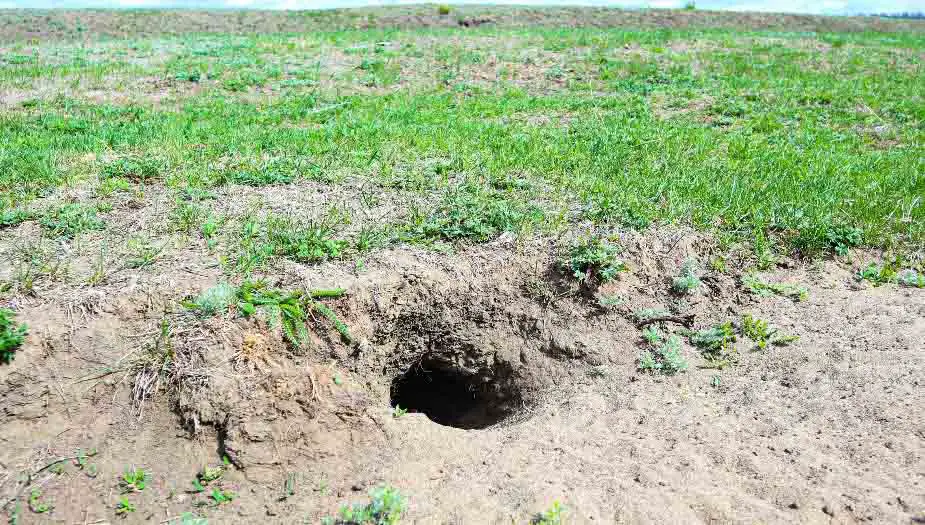There’s a world beneath our feet, intricate, bustling, and elusive. Within this underground realm, gophers construct networks of tunnels and chambers, but it’s the main tunnel that holds the key to their daily activities. How do I find the main gopher tunnel? you might wonder.

As we peel back the layers of earth, let’s journey together into this subterranean spectacle to unearth the secrets of gopher tunnels and how to spot the main artery that sustains their vibrant underground life.
Gopher Tunnel Systems and How To Find Main Tunnel
In the underbelly of our gardens and fields, there exists an intricate maze, designed and executed by one of nature’s finest architects: the gopher. To get a grip on how to identify the main tunnel, it’s paramount to first understand the basics of this labyrinth.
- The structure of complexity:
Gopher tunnels aren’t just haphazardly dug pathways; they’re carefully crafted systems. Typically, a gopher’s burrow comprises a main tunnel that serves as a primary route for its activities. Off this main artery, several lateral or feeder tunnels radiate, leading to the surface or terminating in a dead end. These feeder tunnels are often where you’ll find those distinct fan-shaped mounds of soil. - Differentiating between feeder and main tunnels:
The main tunnel generally runs deeper, approximately 6 to 12 inches beneath the surface, while feeder tunnels tend to be more superficial. While the feeder paths might be used for foraging or occasional activities, the main tunnel is the lifeline, connecting nesting areas, food storage chambers, and sometimes even waste pits.
Signs to Spot the Main Tunnel
To the untrained eye, every mound might look the same, but keen observers can catch nuances that direct them to the main artery of the gopher’s world.
- Surface clues:
One of the most telling signs is the fresh mounds that gophers push to the surface. While smaller, crescent-shaped mounds often indicate feeder tunnels, larger, more expansive, and less frequent mounds can be a sign of the main tunnel beneath. Also, the direction the soil is pushed can provide hints. Soil pushed in a horseshoe or semi-circle suggests a feeder tunnel, but a straight line could point to the main thoroughfare. - Tunnel direction and depth:
As we probe the ground, feeder tunnels might be discovered fairly quickly, just a couple of inches down. They often run perpendicular to the main tunnel. In contrast, if you probe deeper and find a path running parallel to the surface for a lengthier stretch, you’re likely on the main route. - Active vs. abandoned pathways:
Not every tunnel you find is a bustling gopher highway. Gophers frequently abandon certain paths, either due to danger, depleted food sources, or other reasons. Fresh, moist soil, recent digging signs, or even the faint sound of a gopher at work can indicate active tunnels.
The Tools and Techniques for Accurate Detection
The realm of gophers is delicate, and while our curiosity beckons, we must tread carefully, both out of respect for these creatures and to ensure accurate detection.
- Probe methods:
A probing rod is a gopher-hunter’s best friend. This long, often metal tool can be gently inserted into the soil to feel for voids or tunnels. Once you hit a void, you can measure the depth to get a sense of whether it’s a main or feeder tunnel. The key is gentle, repeated probing in the vicinity of fresh mounds. - Safety first:
Always remember that a gopher’s tunnel is its home. Excessive force or careless probing can cause collapses or harm to the inhabitants. Respect their space, and aim to cause minimal disruption. - Technology aids:
In our tech-driven age, gadgets like ground-penetrating radar or acoustic sensors can offer a non-invasive peek into the underground. While these might be overkill for the average gardener, they’re valuable tools for researchers or those deeply invested in understanding these tunneling titans.
Unraveling the secrets of the gopher’s underground world requires patience, precision, and a fair bit of detective work. As we delve deeper, we’re not just locating tunnels but uncovering tales of survival, strategy, and a fascinating way of life that thrives beneath our feet.

Why Identifying the Main Tunnel Matters
While a network of tunnels might seem like a mere curiosity to some, identifying the main gopher tunnel can have practical and enlightening implications.
- For the garden enthusiasts:
If your garden has been a buffet for gophers, knowing the whereabouts of their main tunnel can aid in effective pest control. Planting deterrents or placing traps becomes more effective when you’re targeting the gopher’s main highway. Also, by understanding their movements, you can better protect your cherished plants and crops. - Conservation and respect:
Gophers play a vital role in our ecosystem. Their tunneling activities aerate the soil, aiding in better water penetration and soil health. Recognizing their main tunnel helps in conservation efforts, ensuring we don’t inadvertently destroy key parts of their habitat. - Scientific curiosity:
For biology enthusiasts or researchers, the tunnel systems provide fascinating insights into the behavior, habits, and survival strategies of gophers. Mapping out these pathways can be a window into their subterranean world.
Myths and Misconceptions Debunked
Like many creatures, gophers have inspired a series of myths and tall tales. Let’s set the record straight.
- Popular folklore vs. reality:
Some believe gophers carry a treasure trove of items down their tunnels, from lost jewelry to ancient artifacts. In reality, gophers are simple creatures, concerned more with their next meal and safety than collecting treasures. - Busting myths:
It’s a common belief that flooding gopher tunnels with water will drive them out. While this might occasionally work, it’s not a foolproof strategy. Gophers can create waterproof chambers and might even escape deeper into the ground. Moreover, flooding can erode the soil and damage your garden.
Gopher Tunnels and Main Tunnel Traps
Our journey beneath the surface, into the labyrinth of gopher tunnels, has been enlightening. We’ve discovered the artistry and purpose behind each twist and turn, each chamber, and each mound. The main tunnel, the heart of the gopher’s domain, tells a story of survival, instinct, and the rhythm of life that pulses beneath our feet.
As we step back onto solid ground, we carry with us a newfound respect for these subterranean architects. Whether you’re safeguarding your garden, embarking on a research mission, or merely satisfying your curiosity, the knowledge of the main gopher tunnel illuminates a world teeming with activity, challenges, and natural wonder.
Thank you for joining us on this deep dive. May your gardens thrive, your curiosity be satiated, and may you always find joy in the mysteries that nature continually unfolds.

